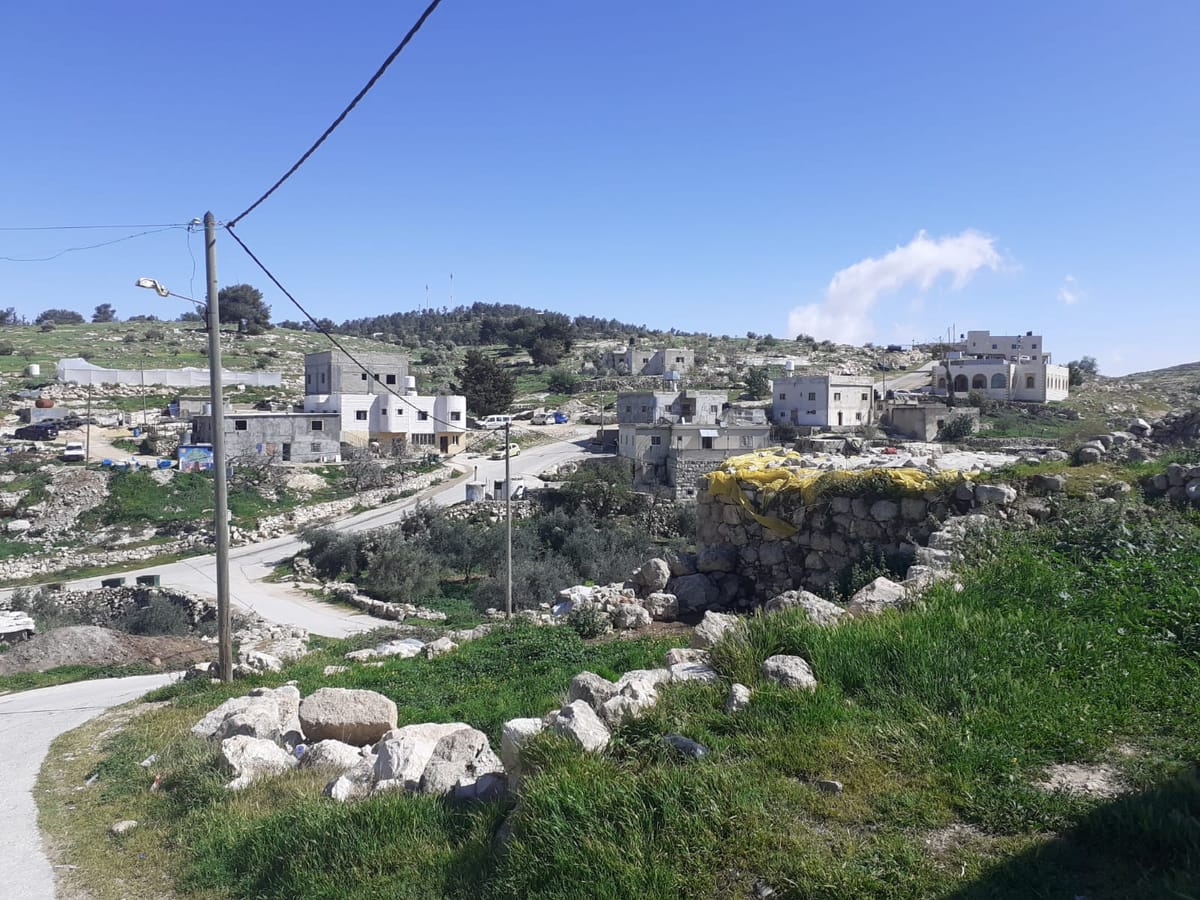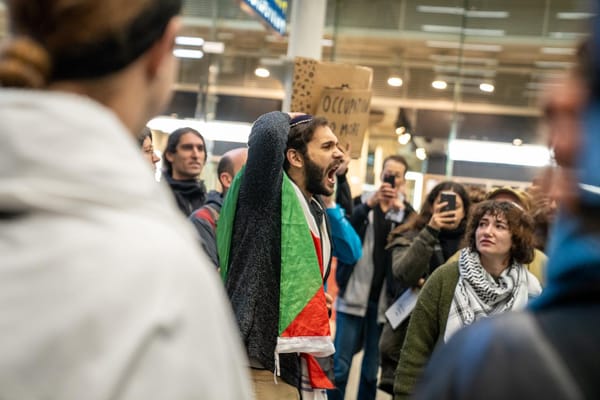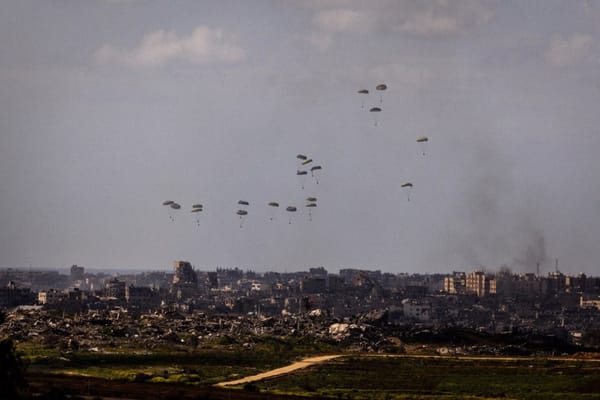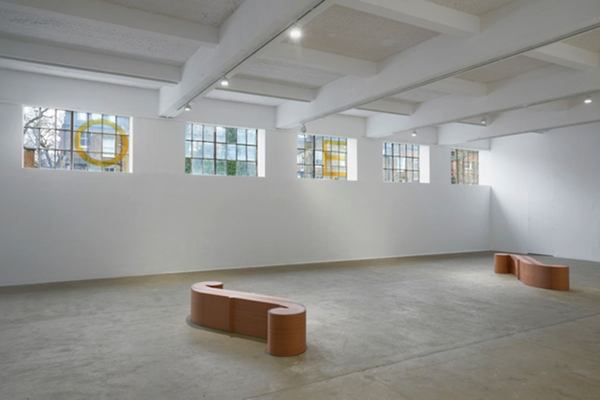Water, water everywhere
A contest over a spring exposes Israel’s water apartheid.

The first thing I noticed about At-Tuwani, a Palestinian village in the South Hebron Hills, was its neighbouring Israeli settlement, Ma’on; where the former was cast in shadow, the latter was bathed in sunlight. “The city that they speak of has much of what is needed to exist,” writes Italo Calvino in Invisible Cities, “whereas the city that exists on its site, exists less.”

Ma’on was built in 1982 on the main road between At-Tuwani and Tuba, another Palestinian village. Twenty years later, residents built an outpost of Ma’on on the other side of the road. The settlers fenced off the private Palestinian land by the roadside, and now use it for agricultural purposes; Palestinians have since stopped using the road due to safety concerns. Ma’on’s brand-new buildings, constructed of uniform beige brick and large enough for any growing family, gleam in the sunlight. Just behind them, white caravans, soon to become houses, dot the hilltop: another outpost. Although Ma’on keeps illegally expanding, residents enjoy government subsidies and piped-in water, the fruits of which – grapes, cherries, tomatoes, potatoes, almonds and olives – saturate the landscape. Apart from a teenager messing around on a motorcycle, the settlement feels empty.
At-Tuwani’s roots go deeper. The village was built in the early nineteenth century on the ruins of Khirbet at-Tuwani, which can be traced to the Middle Ages. Ramshackle and dusty, its older buildings appear to blend into the rocky landscape that itself provides shelter; many of At-Tuwani’s residents live in caves. The village’s more modern buildings are constructed of varying configurations of stone, wood and tarpaulin and seem permanently half-finished, with glassless windows and iron rods shooting out of the stone. Apart from the scurrying chickens, it is still. Hidden among the mismatched dwellings, a small museum photographically documents the violence of occupation: an old woman lamenting uprooted olive trees; a farmer clubbed by masked settlers; children being escorted to school by soldiers to protect them from settler attacks; poisoned sheep laid out on the road, covered in flies (Israeli police have refused to examine the poison-covered barley laid near one of the area’s few natural water sources, where villagers graze their sheep). Yet At-Tuwani is the envy of other Palestinian villages in the vicinity because, after years of petitioning, it is connected to the water infrastructure, while its neighbours are forced to collect rainwater.

I spent time in At-Tuwani in December and January on a delegation with the Center for Jewish Nonviolence (CJNV), a non-violent anti-occupation movement of Israeli and diaspora Jews that works in partnership with Palestinian resistance movements. CJNV runs two delegations per year, and there were about fifty people on mine. Most were American: there was Sara, 30, from Arizona, who helps Mexican migrants cross the border; Stephen, 52, from California, who campaigns against nuclear weapons and has volunteered in Afghanistan. There were old-timers who’d been on numerous delegations and newbies, like me. There were those who felt alienated from Judaism by their activism (“If my rabbi was anti-occupation,” I heard one say on the minibus, “I would definitely go to temple”), but also four rabbis.
We stayed in Beit Jala in Bethlehem but spent most of our time in At-Tuwani. On the first night of the trip, we were treated to traditional Palestinian hospitality in the Sumud Freedom Camp. The camp is a plot of land in Sarura in the South Hebron Hills whose inhabitants Israel drove out between 1980 and 1998, and which in 2017 a group of 300 Palestinian, Israeli and international activists reclaimed. The landscape is empty, receding into more rocky hills as far as the eye can see. This is a place where the sun sets dramatically, and where dog howls fill the night. The camp is built from old tyres, Palestinian flags, a couple of tents and a large cave, which is surprisingly cosy inside. The Palestinian Youth of Sumud movement slept in this cave every night for two years in order to avoid it being taken over by settlers. That night we crowded into it, and after lots of maqluba washed down with dabke dancing, the night ended abruptly in a power cut.
The control of utilities is one of the primary mechanisms of occupation; power cuts are daily, and the taps often run dry. Under international law, both the Jordan River that runs along the eastern border of the West Bank and the Mountain Aquifer that underlies the West Bank and Israel are “transboundary water resources”, meaning that they should rightly be shared by Israel and Palestine. However, when Israel began occupying the West Bank in 1967, it claimed control of Palestinian water resources under the guise of military law. Eventually Israel prevented Palestinians from accessing the Jordan River. The 1995 Oslo II Accords, intended as a temporary agreement, grant them access to just 17 per cent of the aquifer, though only a fraction of this is successfully received since Israel refuses pipeline repairs, meaning much of it is lost to leakage. Palestinians have since lived with a constant and largely manmade shortage of water.
The control of utilities is one of the primary mechanisms of occupation; power cuts are daily, and the taps often run dry.
Meanwhile, Palestinian attempts to create an autonomous water system have been systematically shut down. In 2019, the residents of At-Tuwani allowed the 12 surrounding Palestinian villages to connect to their water supply; a few months later, Israel confiscated the shared pipe. This mirrors a broader picture. In Area C, construction is largely prohibited; last year, 98 per cent of building permit applications were rejected. This leaves Palestinians with little choice but to build without permits, resulting in the routine destruction or confiscation of water, sanitation and hygiene structures, including cisterns, wells, water tanks, toilets and sinks, often in the most abject of ways.
As a result, Palestinians – quite literally a captive market – have no option but to buy water from their occupiers at inflated prices. Palestinians with no access to the water grid are forced to truck in water from the Israeli state-owned water company Mekorot, paying expensive fees to the truckers that drive up the cost of water by around 3.5-5 times, and that leave Palestinian households spending up to one-fifth of their income on water. Where Palestinian communities are connected to the water infrastructure, the pipes are smaller in diameter than those servicing settlements, resulting in lower pressure. Palestinians are used to rationing water, especially during the summer months, when Mekorot reduces or temporarily suspends supplies in order to irrigate settlers’ farms and gardens. While an Israeli within the Green Line has access to an average of 240 litres of water per day, in the West Bank settlers have more than 300, while Palestinians have 73; in some parts of the West Bank, the average drops to as low as 20. The World Health Organisation’s minimum standard water supply is 100 litres.
The heavily promoted settler-colonial narrative that Israel “made the desert bloom” obscures its apartheid water system. It is used as an environmental justification for this mechanism of control: for example, the JNF trees intended to cover up the ruins of Palestine and still today used to evict Palestinians from their homes – incidentally so overzealously planted they are suspected of having adverse environmental effects. While Israel boasts of being a global water powerhouse – leading the way in drip irrigation, desalination, treated wastewater, and creating water literally from thin air – 97 per cent of Gazan tap water is unfit for human consumption (leaving the strip extremely vulnerable to coronavirus). Just as Gaza has been desiccated by aerial bombardment and an ongoing blockade, the water-rich Jordan Valley, which the World Bank says is essential for Palestinian economic development, is due to be annexed by Israel next month. It is clear that in the eyes of the Israeli state, the desert will only bloom if it is drained of Palestinians.
Those not fortunate enough to be connected to the water system, or rich enough to truck in water from Israel, must tap up natural water sources – though even these are not without their challenges. The Avigail Spring near At-Tuwani has been used by Palestinians for generations. However after the Israeli outpost of Avigayil was established there in 2001, settlers began to swim in the spring, rendering its water undrinkable, and when Palestinians did attempt to draw water from the spring, they faced aggression and intimidation from settlers. The spring is one of more than 60 in the West Bank that have been taken over or are at risk of takeover by Israeli settlements and authorities. Our delegation’s mission was to help Palestinians restore their access to it.
The spring is one of more than 60 in the West Bank that have been taken over or are at risk of takeover by Israeli settlements and authorities. Our delegation’s mission was to help Palestinians restore their access to it.
We had planned to leave Bethlehem at daybreak, but after receiving a tip-off that the IDF knew we were up to something, we left in the middle of the night, so that we could get to the spring at first light. Bring nothing, CJNV told us, except your passports and the number of a human rights lawyer. Contact lenses were advised against because of tear gas. Our packed bags were waiting in the hotel reception in Bethlehem.
As the sun came up, we hiked over the rocky hills towards the spring, carrying olive saplings and shovels. Palestinian women led the way, one on a donkey, retracing the route they travelled to the spring as younger women. When we reached the spring, we cleared the entrance of weeds and rubbish, and planted the trees. Our Palestinian partners plastered a new road sign over the existing one, with the original Arabic name – Ein Albeida, meaning “white spring” – and erected a Palestinian flag.

Our victory didn’t last long. As we worked to restore the spring, a carful of settlers drove past. “All dogs die like this,” one shouted, miming slashing his throat. Another pulled up, ripped down the flag and began squaring up to some of the Palestinians. Soon after, the IDF showed up, and announced that the area was a “closed military zone” (they can do this anywhere in the West Bank, and once they have, remaining on site means risking arrest. It is a tactic commonly used to shut down protests across the occupied territories, and usually the step before more violent dispersal techniques such as teargas or stun grenades). We crowded round the Palestinians as they filled their tanks from the spring, acting as a buffer between them and the soldiers. Meanwhile, the soldiers became increasingly agitated; one, in an attempt to bargain with us, said that he opposed the occupation, too.

Despite this, the action was a success: Palestinians drew water from Ein Albeida for the first time in nearly 20 years, and without any major escalation from the settlers or soldiers. Children ran around cheering and handed out endless cups of sweet tea; the adults were more muted. “I am so happy to be back,” Kifah Adara, an activist who has lived in At-Tuwani her whole life, told us. Part of me wondered how much of their positivity was performed for us.

On the trek to the spring, some of the delegates suggested we sing; CJNV encouraged group song to keep spirits high and to emphasise the nonviolent approach of our anti-occupation work. The song we settled on was one many Jewish kids will have sung in school:
Ushavtem mayim b’sason mimainei hayeshua. Mayim, mayim, mayim, mayim. Hey, mayim b’sason.
With joy you shall draw water from the springs of salvation. Water, water, water, water, joyful water.
Out of respect for our Palestinian partners, we sang in English. No matter how beautifully sung, Hebrew would feel like an encroachment; to them, it’s the language of occupation. “Wahderr, wahderr, joyful wahderr,” I found myself drawling, along with the Americans. On Shabbat, however, we proudly wore our Judaism, sung prayers in Hebrew and wore kippot. Although it was peaceful, I felt uncomfortable. On the one hand, it would have felt strange to spend Friday night with a Jewish group and not perform the Shabbat rituals; on the other, I couldn’t shake the sense that we were asserting our Jewish identity in the Palestinian Territories. I felt a bit like a settler.
It struck me that many people had come on the delegation to strengthen their connection between Judaism and anti-occupation activism, to ground the former in the latter. Yet what transpired, for me, was how difficult it was to square Judaism with a desire to fight for Palestinians whose oppression had in part been justified by Judaism. My sense of Jewishness was not solidified by the trip, rather it was rendered more fluid by it, something that, like water, could both be liberatory and oppressive.
My sense of Jewishness was not solidified by the trip, rather it was rendered more fluid by it, something that, like water, could both be liberatory and oppressive.

The day after our action, I found out that the entrance we had cleared had been destroyed and the olive trees uprooted. Some of the CJNV organisers went back and repeated the work, and it was undone again. The recurring nature of anti-occupation work often feels dismally predictable; the victories as fleeting as trying to hold water in your hands. But I imagine the organisers will keep returning for as long as joyful water flows from Ein Albeida. ▼
Tamara Stanton is a member of Na’amod: British Jews Against Occupation.




